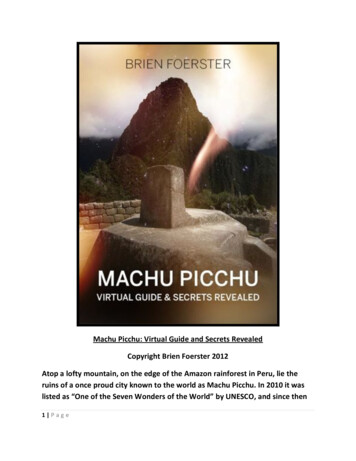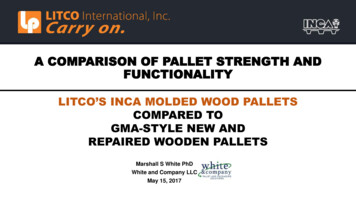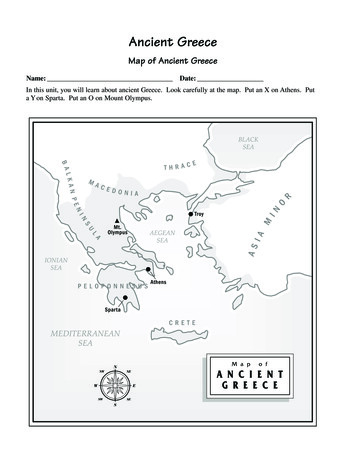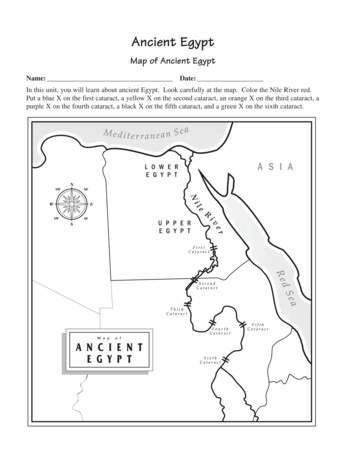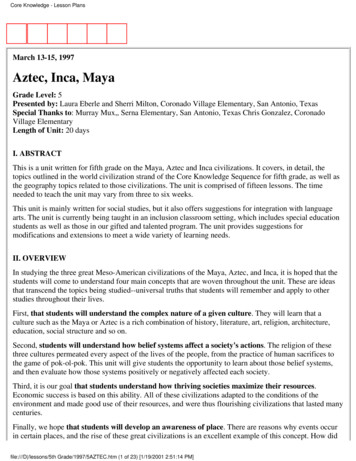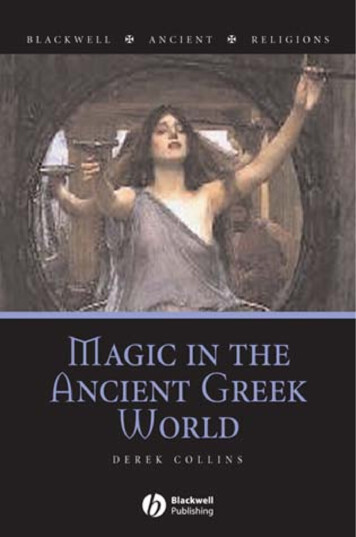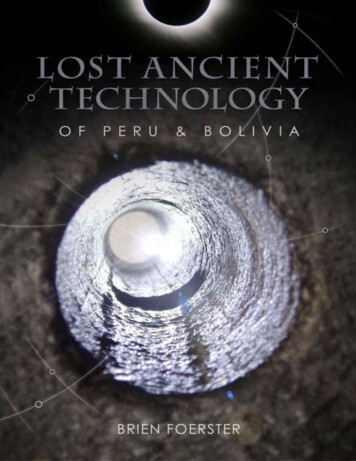
Transcription
Lost Ancient TechnologyOf Peru And BoliviaCopyright Brien Foerster 2012All photos in this book as well as text other than that of the author are assumed tobe copyright free; obtained from internet free file sharing sites.
DedicationTo those that came before us and left a legacy in stone that we are trying tocomprehend. Although many archaeologists don’t like people outside of
their field “digging into the past” so to speak when conventionalexplanations don’t satisfy, I feel it is essential. If the engineering feats ofthe Ancient Ones cannot or indeed are not answered satisfactorily, if theage of these stone works don’t include consultation from geologists, and ifthe oral traditions of those that are supposedly descendants of the masterbuilders are not taken into account, then the full story is not present.One of the best examples of this regards the great Sphinx of Egypt, datedby most Egyptologists at about 4500 years. It took the insight andquestioning mind of John Anthony West, veteran student of the history ofthat great land to invite a geologist to study the weathering patterns of theSphinx and make an estimate of when and how such degradation tookplace. In stepped Dr. Robert Schoch, PhD at Boston University, whoclaimed, and still holds to the theory that such an effect was the result ofrain, which could have only occurred prior to the time when the Pharaoh,the presumed builders, had existed.And it has taken the keen observations of an engineer, Christopher Dunn,to look at the Great Pyramid on the Giza Plateau and develop a very potenttheory that it was indeed not the tomb of an egotistical Egyptian ruler, asin Khufu, but an electrical power plant that functioned on a grand scalethousands of years before Khufu (also known as Cheops) was born.I salute such brave people, as well as Graham Hancock, Robert Bauval,Stephen Mehler and many others who boldly use observation and logic tobreak through paradigms which have run their course and frankly nolonger work. The only way to truly understand the brilliance of ourcollective ancestors is to approach what they have left behind for us in asystematic and multi-disciplinary way. A complete understanding requiresa holistic approach.In the case of Peru and Bolivia, there are neither the fire storms ofdisagreement nor the extensive analysis of historical artifacts as seen inEgypt. In some ways this is both a blessing and a curse for me; I am
blessed to be able to study megalithic and other works without muchopposition, but in some ways cursed by having too few academics andexperts to draw from. The search goes on, and this is my first treatise ontrying to figure out when and how all of the amazing and puzzling stonemasterworks of Peru and Bolivia were, but not my last. Thanks especiallyto Christopher Dunn, Dan Guthrie, Arlan Andrews and Mike Mahar forlending their engineering wisdom and knowledge in the field, and mybeloved Irene for never allowing me to quit.Forewordby Dr. Arlan Andrews, Sr., P.E.A wise man once said, "The best teacher is one who shows you where tolook, but does not tell you what to see." Although Brien Foerster does notclaim to be a "teacher," he is indeed one who can show you where to look,but will not tell you what to see. Traveling through the Sacred Valley andother places in Peru with Brien is an absolute delight; you know that youwill experience quite a different journey than any ordinary tourist could,and will begin to sense the mystery and majesty of layers of ancientcivilizations. And start to wonder at the obvious mysteries laid out beforeyou.During our ten days in Peru in April 2012, Brien took my son Sean and menot only to the usual tourist-infested public sites, but also to many off-road(and uphill!) unique huacas that international visitors seldom see. Hepointed out various symbols and patterns that were suggestive of ancientmeanings, but left the interpretations to us. He participated with us as wespeculated on the uses and interpretations of various stone works, carvingsand architectural configurations. And co-wrote an article with us, "ThreeCourses to Cusco", which may yet be published in ATLANTIS RISINGMAGAZINE.In the evenings, over a few brews, Brien would sometimes offer up his
own inner feelings about the marvelous ruins we had crawled over andthrough that day, but always as his own personal insights, neverdemanding acceptance, only a hearing. His belief that some of thestructures we had seen were well over 10,000 years old has been givencredibility by reports in November 2012 that archaeologists had proventhat some of the Peruvian coastal sites have been dated back to nearly14,000 years ago. Again, it seems that every new discovery drives theantiquity of the ancients further and further back into the past. On thispoint, Brien and I agree that the major discoveries are yet to come,especially as we find out how the stone works were fabricated. As Brienquotes me in this book: "Explaining lost ancient technology depends inlarge part on finding lost ancient tools."Although only lightly touched upon in this book, Brien's passion for theElongated Skull Peoples of ancient Peru may yet bring new understandingto a subject that all others have either neglected or ignored. It may well bethat the "Lost Ancient Technology of Peru and Bolivia" depended as muchon "lost ancient peoples" as it did on "lost ancient tools." If that turns outto be the case, then Brien will deserve credit for demanding that thearchaeological world -- and indeed, all humanity --pay attention.Another wise man once said, "Imagination is looking at what others havelooked at, but seeing what others have not seen."Thank you, Brien Foerster, for your knowledge and your imagination.Table Of Contents1/ Introduction2/ Sachsayhuaman3/ Qenqo
4/ Amaru Machay5/ Coricancha6/ Inca Roca Wall7/ Pisaq8/ Naupa Iglesia9/ Ollantaytambo10/ Machu Picchu11/ Inti Punku12/ Temple Of Viracocha13/ Pucara14/ Sillustani15/ Chucuito16/ Amaru Muru17/ Tiwanaku And Puma Punku18/ El Fuerte De Samaipata19/ Quillarumiyoq20/ Saihuite
21/ Vilcashuaman22/ Intihuasi23/ Huaytara24/ Huanuco Pampa25/ Chavin De Huantar26/ Cumbemayo27/ Conclusions28/ Bibliography1/ Introduction
Exploring a secret cave in Peru with the brilliant Christopher DunnWhen one thinks of Peru, in a historical context, the names thatimmediately spring to mind are the Inca, and the Spanish Conquistadors;that is, if any knowledge of this South American nation is known at all.The Inca were the largest civilization of the pre-Columbian Americas, andthe Conquistadors were a small group of Spanish soldiers of fortune whoutterly decimated these proud and advanced people beginning in 1532,under the leadership of Francisco Pizarro. The details of how the“conquest” by this group of 160 odd Europeans of the great Inca wasconducted and achieved is accounted in my book A Brief History Of TheIncas: From Rise, Through Reign To Ruin, available as a print book
from www.adventuresunlimitedpress.com as well as many bookstores inPeru, including on top of Machu Picchu. It and my other titles can also bepurchased as e-books from www.hiddenincatours.com andwww.amazon.com, and as paperbacks from www.lulu.com
The sole purpose, if one reads all of the Spanish accounts and oraltraditions of the Inca descendants of the “conquest” was to obtain by anymeans the vast wealth of the Inca, mainly gold but also silver whichPizarro and his motley group of Spanish misfits had heard rumours ofwhile they were in Panama, years before. Local Panamanian natives couldnot help but notice the Europeans’, and especially Pizarro’s obsession withthe gold amulets and nuggets that adorned some of the indigenous peoples’necks, and one chief is said to have expressed that if the Spanish were sohungry for this metal, they should go to a place called Pelu, south and westof Panama. He said that gold was so plentiful that the people ate fromplates of the material, and drank from golden cups.What few readers will know is that the first two of three attempts byPizarro to find this mysterious, and what would turn out to be elusive (aswritten about in my aforementioned book) “Pelu” were not governmentsanctioned voyages, they were in fact the acts of very desperate men.Pizarro was born illegitimate, and was raised as a swine herd in a ruralarea of Castile, Spain. His aspirations were to leave his native land as soonas possible and thus set out, as many did, for the so called “New World”where gold and other riches were said to be plentiful and easy to obtain.The problem that he and others faced was how to pay for passage? Asmany if not most of the emigrants to the “New World” were at the bottomrung of the social classes, they had to barter their way across the Atlantic.Often they wrote, or at least signed (commonly with an X, being illiterate)a promissory note which clearly stated that they would repay a loan oncethey struck it rich in this mysterious and far off land of plenty. Theproblem was, to a great extent they were duped, because Panama had littleto offer, aside from disease, heat, humidity and a desperate population ofNative people who were waning due to previous European encounters.Thus, the plight of Pizarro and many others was; return to Spain anddebtor’s prison, or do whatever it took to acquire wealth, and that meant
literally anything. In general, it was not hard for Pizarro to rally a crewfrom amongst Panama’s expatriate population. With promises ofunbelievable wealth they set off, and on the third attempt landed on theshores of what is now called Peru, and the rest, as they say is history.More pertinent to the topic of this book is what the Spanish (I will nolonger use the term conquistador in this book, as it is fiction that there wasany nobility, honour or ethics in any of their pursuits) encountered oncethey arrived in Cuzco, the Inca capital, having ravaged the localpopulations and their wealth all along the way from their first footsteps onthe shore.The chronicles written by the Spanish show that these Europeans were inawe and bewildered by some of the stone structures presumably built bythe Inca and/or their ancestors. Massive constructions, such as themegalithic Sachsayhuaman above Cusco seemed inconceivable; how couldthese Natives have shaped and manipulated multi-ton blocks of hard stone,at least one of which weighed 125 tons? And perhaps even moreimpressive, no mortar or cement of any kind was evident, the stonesappearing to, in some cases fit so well that a piece of paper could not fitbetween them?In some of the “first contact” and colonial period writings, mainly pennedby the Spanish, Inca descendants are said to have stated that some works,such as the great zigzag wall of Sachsayhuaman, which we shall discussfirst, were made by ancient people, in fact giants. Whether “giants”referred to beings of great stature or immense intellect is uncertain. Also,one must take into account that the Spanish, from their first encounterswith the Inca and other Native people in generally treated the Indigenouspeople of these lands with contempt, and the Europeans felt a sense ofsuperiority.This was shown by the banishment and wanton burning of the Inca Khipusystem of knotted cords, which clearly was not only a form of accounting,
but indeed some surmise could have also been a form of recordedlanguage. As well, temples, starting with the Inca “holiest of holies” theCoricancha in Cusco were torn down to their foundations soon after theSpanish entered this Inca capital city, to be replaced by Catholic churchesand other colonial buildings.To systematically remove a peoples’ belief system means to control notonly their spirituality, but also their sense of self and identity, thus, onemust consider that some of most of what the Inca descendants “taught” theSpanish invaders was not the reality of their history. Why would you tellan oppressor your most sacred information.Though the Inca are now gone as a civilization and a people, and much oftheir history literally burnt in front of their eyes (as in the Khipu)magnificent stone structures, built by them and those that preceded themremain, in abundance.Much of the Inca city of Cusco was taken apart by the Spanish colonials inorder to build their own structures. Many Inca period buildings were madeup of andesite and basalt stone blocks approximately one cubic foot insize. Therefore, it was not only easy for the Europeans to take these wallsapart in order to construct their own, but it saved them the time and effortof establishing and working their own quarries.The megalithic walls were, I am sure left as a last resort for buildingmaterials. The sheer size, hardness, and location of many of the stones andstructures meant that they would require incredible effort to break up,transport and shape. Luckily they still exist, somewhat bruised but notbroken for us to examine and enjoy today. And kudos to the PeruvianGovernment for assisting in their preservation.The wonton destruction of Inca and older buildings not only deprives us ofa thorough inventory of the historical construction record of the past.Because of the brutal nature of the conquistadors, the imported diseases
that wiped out at least half of the Native population, and the fear as well aschaos that ensued, much more was lost knowledge.Anyone with any kind of astute sense of vision can see, while walkingthrough the streets of Cusco for example, that many different styles of preColombian construction exist, from adobe walls to tight fitting and mortarfree works in stone which stupefy modern engineers and masons.This book is an attempt to explore the idea that civilizations existed longbefore the Inca and were capable of manipulating stone in ways that wecan scarcely imagine, using technologies which we presently don’t seem tohave.2/ Sachsayhuaman
Engineer Arlan Andrews inspecting an ancient shaped surface nearSachsayhuamanAside from the gold and silver that adorned the walls of temples, whichthey took with brute force of course, they visited a site above the citycalled Sachsayhuaman, which, depending on the source you consult eithermeans “Head of the Puma”, “Head of the Falcon” though the formercarries more weight since it is well known, amongst the oral traditions ofthe Inca that the city of Cusco, prior to Spanish occupation in 1533 wasformed in the shape of a puma, with Sachsayhuaman forming the head, inthe north. A more recent meaning I have been told, through my friend whois a Native guide in the Cusco area, Rogelio Gibaja Tapia forSachsayhuaman is “head of completion” or “place of completion.” This
would be a spiritual name and understanding.What astonished the Europeans, and does with visitors to this day was thesize of the hewn stones that make up the first tier (of which there are three)of the zigzag wall and surroundings. The largest weighs upwards of 125tons, and is almost 30 feet tall, 12 of those feet being buried in the groundand thus forming a very firm foundation, necessary to keep the wall stableas Cusco is a very seismically active area.
The author below the Puma paw section of SachsayhuamanIt is and was not only the size of the stones, but the fact that they fitprecisely together without any kind of mortar, and that each stone isunique in shape and volume; more complex than any that the Spanish hadseen in their European homeland. How could “natives” have achievedwhat white God fearing Catholics had not was their question? The answersvary, depending what source you consult. As most of the Spanishchronicles of the time and soon after tend to have a racist tinge to them,and the most famous Inca account was written by the half Inca Garcilasode la Vega, who left Peru in his early twenties and wrote his historicalaccount in Spain under the watchful eye of church and state, one must siftcarefully.
The zigzag wall of Sachsayhuaman and a curious stone in frontA common statement from the Inca sources of the time was that themegalithic aspects, such as the giant zigzag wall were built by “giants”prior to Inca occupation, which occurred around 1100 AD, and/or by themysterious Viracochan people who had pre-existed the Inca. Incaconstruction did of course occur in the area, but as we shall see later on inthe book, the scale and craftsmanship of the work does not compare withwhat I and others regard as the work of the far earlier and more superior“megalithic builders.”This is in no way meant to belittle or simplify the Inca and theiraccomplishments, but a careful look into the archaeological record clearly
indicates that the tools found could not have shaped the stones, being of ahardness of 6 to 7 on the Mohs scale (10 being diamond.) Why is this? TheInca knew of metallurgy, obviously, because they worked gold and silver,which turned out to be their downfall at the hands of the Spanish. Theyalso shaped tools, weapons and ornaments out of copper and copper alloys,such as bronze, which is abundant in the highlands of Peru, since the localAndes Mountains are volcanic. Iron is present in the form of iron oxide,and is plentiful in the telltale red soil of the area, but there is littleindication that the Inca were capable of smelting it.Copper and bronze chisels are reasonably common in archaeological digs,but that material is so soft in comparison to the andesite, basalt and granitestones used in the ancient structures at Sachsayhuaman and around Cuscothat one strike would take any cutting edge off the chisel, and repeatedblows would simply bend it. Stone hammers were also employed, but inorder to remove material in any kind of efficient way from the stone(andesite, basalt or granite) being shaped, the hammer would have to beharder.Meteorite material tools as well as those of hematite and iron pyrite havebeen found, and average 6 on the Mohs scale (1) which is more or less, oreven softer that the stone being shaped. These tools, no matter how manyworkers were employed and over how many generations most likely didnot create the zigzag wall at Sachsayhuaman, and many other buildings,structures and shaped outcrops that we shall explore in the coming pages.As stated, the Inca clearly built at the Sachsayhuaman site, but no historicaccounts that I have found indicate how the giant stones which make upthe giant wall were moved, shaped or fitted together. The quarry fromwhich the stones were brought is estimated to be approximately 35 kmaway (2) but the question arises, how would anybody have moved them?The natural answer would be wooden rollers made from tree trunks, butprior to the arrival of eucalyptus from Australia, specifically the Blue Gum
variety in the latter half of the nineteenth century (3) there were no largestraight native trees in abundance.Western scholars who have attempted to explain how the stones weremoved from the quarry, shaped and fitted into place have the following tosay: ‘The stones were rough-cut to the approximate shape in the quarriesusing river cobbles.’ (4) What? ‘They were then dragged by rope to theconstruction site, a feat that at times required hundreds of men.’ (5) Thisquote was written in 1600, more than 60 years after the fall of the Inca.‘Cieza de León, who visited Sachsayhuaman two times in the late 1540’s,mentions the quarrying of the stones, their transposition to the site, and thedigging of foundation trenches. All this was conducted by rotational labourunder the close supervision of Imperial architects.’ (6) However, howcould Cieza de Leon have witnessed the construction in the 1540’s whenthe Inca fell in 1533?I hope that what you are starting to see is that descriptions of theconstruction of such sites like Sachsayhuaman are in the realm ofspeculation after the fact. To add insult to injury, here is another: ‘VinceLee is an author, architect, and explorer who has studied and consulted onvarious ancient sites where people moved large megaliths. He theorizedthat the blocks at Sachsayhuaman were put into place by carving them andthen lowering them into place. The stones would have been preciselycarved in advance to create the tight joints made to fit into preparedpockets in the wall. Then the stones would be towed up a ramp and abovethe wall, where they would be placed on top of a stack of logs. The logswould be removed one at a time to lower the stones into place. In contrastProtzen, a professor of architecture, has shown, he says, how the Inca builtlong and complex ramps within the stone quarries near Ollantaytambo, andhow additional ramps were built to drag the blocks to the constructionabove the village. He suggests that similar ramps would have been built atSachsayhuaman. (7)
It is beyond being “unlikely” that the tools in the archaeological recordcould not have achieved what the above theories speculate upon; and thusit leaves the great zigzag wall of Sachsayhuaman a mystery to this day.But, it is only one of many amazing examples of what I regard as lostancient technological accomplishments at Sachsayhuaman, not to mentionthe city of Qosqo (Cusco) and beyond for us to explore in this book.Inca period tools in a museum in CuscoInca period constructions can clearly be seen if you walk up to the thirdtier of the zigzag wall. They are off to the western side. Recently this areahas been cordoned off with ropes due to archaeological digs, but this maynot be the case if and when you visit. What you will see are small blocks
of stone, often two or three levels in height, and reasonably well shaped.The tell tale white dots on the stones indicate where stone Inca hammershave been used for the final finishing; these are often called “bruisemarks.” If the Inca had shaped the giant megalithic stones of the zigzagwall these bruise marks would be all over the surface of each stone; but isnot the case. Some bruising can be seen, but not in a consistent fashion.The wall sections with the small stones is Inca, but not the restYou will see a large circle of low lying stones. This shows you where alarge tower once stood, torn down by the Spanish as well as all other Incaconstructions in the area. The reason why the Spanish took the Incabuildings apart and not the massive zigzag wall, was because the stones ofthe Inca structures could be easily carried away, and tended to be cubeshaped, and thus could be incorporated into colonial buildings, sinceSpanish masons were used to working with square shapes.This was the case in Cusco itself, where the Inca period buildings, which
tended to be made of stones small and squared off, or field stone couldeasily and quickly be used to construct walls, and since the Spanish knewhow to use concrete, which the Inca did not. In fact, close inspection of thecolonial buildings shows you that the Spanish masons sometimes usedconcrete mortar of more than an inch in between the set stones, and thisaccounts for their weakness when it comes to earthquakes, which arefrequent in Cusco. The concrete is softer than the hard Andean stones, andthus crumbles during a tremor, while many of the Inca buildings weredesigned to withstand earthquakes, and the pre-Inca megalithic structuresdo not waver, and have not for thousands of years.Proposed Inca stone work and later Spanish “repairs” using mortar
Following the siege of Cusco in 1556, when the puppet high Inca, calledManco Inca (set in place by Pizarro in order to appease the Nativepopulation) decided to burn Cusco to the ground from Sachsayhuaman byvolleying flaming projectiles, the Spanish rebuilt the city.Sachsayhayhuaman and other sacred structures were destroyed block byblock to build the new governmental and religious buildings of the city, aswell as the houses of the wealthiest Spaniards. In the words of Garcilasode la Vega, the half Inca writer, “to save themselves the expense, effortand delay with which the Indians worked the stone, they (conquistadors)pulled down all the smooth masonry in the walls. There is indeed not ahouse in the city that has not been made of this stone, or at least the housesbuilt by the Spaniards.” (8)Sachsayhuaman is an enormous site, and much larger than the zigzag wallsand structures that lie (or once did) on top of it. It spreads out to the northand east by probably hundreds of hectares; in fact, new archaeologicalstudies keep extending its size, so no one really knows how large it is.When viewed from the southern and south western hills, one notices thatthe whole of the hill on which it rests, rising above Cusco, is terraced. Butthe terracing is so covered by foliage over the course of the last 500 yearsthat stone walls, some being massive megalithic ones, may be yet to beunearthed.The Cusco expert of the megalithic structures of Cusco and the SacredValley, Jesus Gamarra, whose father Alfredo preceded him, showed methe interior of a restaurant part way down the flank of Sachsayhuaman.Here we saw a truly megalithic wall, and Jesus insists that the entire hill isan ancient megalithic pyramid, capped by Sachsayhuaman, and far olderthan the Inca. More of his work and thoughts, as well as information abouthow to hire him as a guide can be found at: www.theorigintour.com Also,he has created DVDs called “Cosmogony Of The Three Worlds” and“Etemenanki: The Tower Of Babel In Cusco Peru” which are available viaJan Peter de Jong at: www.ancient-mysteries-explained.com
Traveling north from the zigzag wall, and across the grass field where theyearly Inca “rebirth of the sun” spectacle called Inti Raymi is held on June24, mainly for tourists but also a profound celebration of Inca majesty andculture, you will face a huge exposed bedrock mound, with stairs leadingup onto it. This is where we find our next amazing example of lost ancienttechnology evidence. It is called Suchuna in Quechua, but I do not knowwhat that means in English.The average local tour guide will tell you, based on informationindoctrinated into him or her from the western archaeological biasedtourism school that you are looking at thrones, used during Inca times bythe high officials of the Inca civilization to observe festivals happening onthe grassy plain you just walked across. The problem with this idea is thatthe “thrones” face west, while the grassy “parade ground” is to the south,causing the Inca to wrench their necks in order to observe the pageantry.
The Suchuna “observatory” at SachsayhuamanFar more logical is the idea that this was a calendar of some sort, eithersolar, lunar or both. Soltices and equinoxes seem to line up with the 13steps there, and of course 13 is the number of moon cycles in a year.However, it is unlikely that the Inca shaped it. Again, the stone here is theever present andesite, with hardness of 6 to 7 on the Mohs scale, andheavily layered with even harder quartz crystal. Did the Inca use it? Mostlikely, but did they shape it? Doubtful.One thing to know and keep in mind is that the amazing megalithicstructures in Cusco, the Sacred Valley of Peru and elsewhere are rarely inisolation. Where you find one you will often find others in close proximity,
and this is perhaps especially true at Sachsayhuaman, Ollantaytambo in theSacred Valley, and Machu Picchu.Observations with Chris Dunn in August 2012: almost perfectly levelOne thing I will also endeavour to do in this book is to call the structureswe find by their Native Quechua names wherever possible, and basicallyrefuse to use any Spanish ones, as they are often tainted by Catholicinfluence. The original names of the megalithic places will most likelynever be known, so the Inca ones will be the best that we can find. In someinstances the English will have to be used, for those places to which Idon’t yet know their Quechua names.
One case in point is a rarely (thankfully off the worn tourist route) visitedspot, still used today for ceremonies, called, in English, the Temple of theRainbow. As the Spanish name translates as “the devil’s door” you can seewhy I wrote the above rant. But more of that later Moving further north, beyond the 13 finely crafted “thrones” andfollowing a trail slightly to the left we encounter a fine example ofextremely ancient cut out flat and vertical surfaces, again referred to bylocal guides as yet more Inca “thrones.”Engineer Dan checks the flatness of services with meThis is called the Inca graveyard by most guides, which may be true. The
area was only excavated in the 1990s I believe, and complete skeletons inthe foetal position were found, but were they Inca? That is as yetunknown, as they have not been carbon 14 tested for age. What does makethem intriguing however is that some have elongated skulls, a subjectcovered in my book with David Hatcher Childress called The Enigma OfCranial Deformation; Elongated Skulls Of The Ancients, availablethrough www.adventuresunlimitedpress.com and alsowww.amazon.com.Two of the elongated skulls presumably found at SachsayhuamanThis opens up a real can of worms, because elongated skulls, in myopinion and as continued research suggests, are associated with megalithic
structures and these “Inca” may be the descendants of those that built theancient things we are and will be looking at. The amount of erosion on thehard andesite stone, presumably from rainfall would indicate that muchmore than 500 or so years have passed since these surfaces were shaped,and there is no evidence of tool marks.One stone, seemingly snapped into three gigantic sections is especiallyintriguing, not only because it appears to have been snapped by somegigantic catastrophe, but also because it appears to be upside down. Thismay indicate, though not yet proven, that the violent upheavals thatseemingly occurred somewhere in the region of 12,000 years ago, resultingin the ending of the last ice age, melting of the ice sheets and causing aglobal rise of the oceans by approximate 350 feet, could have caused this.And this could add to the evidence that we are exploring here.
to be the case, then Brien will deserve credit for demanding that the archaeological world -- and indeed, all humanity --pay attention. Another wise man once said, "Imagination is looking at what others have looked at, but seeing what others have not seen." Thank you, Brien Foerster, for your knowledge and your imagination. Table Of Contents
